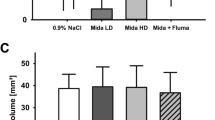Abstract
Brain trauma may alter the function of the blood-brain barrier (BBB) and affect psychomotor activity. We have shown that the transport system for tumor necrosis factor α (TNFα) at the BBB undergoes regulatory changes after spinal cord injury. In this study, we show in CD1 mice that mild trauma by weight-drop to the right temporal region specifically increases the uptake of blood-borne TNFα. This increase, measured by use of radiolabeled murine TNFα, occurred only in the right hippocampus 24 h after injury and returned to normal at 1 week. There was no increase in the uptake of the vascular marker albumin at 1 h, 24 h, or 1 week postinjury, indicating that the BBB remained relatively intact. Human interleukin-1β, which does not cross the BBB by saturable transport, showed no significant changes in brain uptake after trauma. Therefore, the selective entry of TNFα in the injured right hippocampus may be explained by enhanced transport across the BBB. To explore the functional relevance of this transport regulation, we measured mouse behavior by the staircase test. The number of rearings, mainly reflective of exploratory behavior, decreased at 1 h and 1 day after injury but increased at 1 week after a 30-g weight-drop injury. The number of stairs ascended, mainly indicative of locomotor activity, was unchanged at all times tested. We conclude that mild, blunt brain trauma involving the hippocampus causes specific upregulation of TNFα transport and a selective change in exploratory behavior. Although no causal relationship can be established at this time, the behavioral changes might be related to the increased TNFα transport after trauma.



Similar content being viewed by others
References
Banks WA, Kastin AJ (1990) Editorial review: peptide transport systems for opiates across the blood-brain barrier. Am J Physiol 259:1–10
Banks WA, Ortiz L, Plotkin SR, Kastin AJ (1991) Human interleukin (IL)1α, murine IL-1α and murine IL-1β are transported from blood to brain in the mouse by a shared saturable mechanism. J Pharmacol Exp Ther 259:988–996
Banks WA, Audus KL, Davis TP (1992) Permeability of the blood-brain barrier to peptides: an approach to the development of therapeutically useful analogs. Peptides 13:1289–1294
Banks WA, Farr SA, La Scola ME, Morley JE (2001) Intravenous human interleukin-1alpha impairs memory processing in mice: dependence on blood-brain barrier transport into posterior division of the septum. J Pharmacol Exp Ther 299:536–541
Bartholdi D, Schwab ME (1997) Expression of pro-inflammatory cytokine and chemokine mRNA upon experimental spinal cord injury in mouse: an in situ hybridization study. Eur J Neurosci 9:1422–1438
Emmanouil DE, Quock RM (1990) Effects of benzodiazepine agonist, inverse agonist and antagonist drugs in the mouse staircase test. Psychopharmacology 102:95–97
Fan L, Young PR, Barone FC, Feuerstein GZ, Smith DH, McIntosh TK (1996) Experimental brain injury induces differential expression of tumor necrosis factor-alpha mRNA in the CNS. Brain Res Mol Brain Res 36:287–291
Fassbender K, Schneider S, Bertsch T, Schlueter D, Fatar M, Ragoschke A, Kühl S, Kischka U, Hennerici M (2000) Temporal profile of release of interleukin-1β in neurotrauma. Neurosci Lett 284:135–138
Gabellec MM, Crumeyrolle-Arias M, Le Saux F, Auriou N, Jacque C, Haour F (1999) Expression of interleukin-1 genes and interleukin-1 receptors in the mouse brain after hippocampal injury. Neurosci Res 33:251–260
Gutierrez EG, Banks WA, Kastin AJ (1993) Murine tumor necrosis factor alpha is transported from blood to brain in the mouse. J Neuroimmunol 47:169–176
Hayashi M, Ueyama T, Nemoto K, Tamaki T, Senba E (2000) Sequential mRNA expression for immediate early genes, cytokines, and neurotrophins in spinal cord injury. J Neurotrauma 17:203–218
Holmin S, Schalling M, Hojeberg B, Nordqvist AC, Skeftruna AK, Mathiesen T (1997) Delayed cytokine expression in rat brain following experimental contusion. J Neurosurg 86:493–504
Lau LT, Yu AC (2001) Astrocytes produce and release interleukin-1, interleukin-6, tumor necrosis factor alpha and interferon-gamma following traumatic and metabolic injury. J Neurotrauma 18:351–359
Montoya CP, Campbell-Hope LJ, Pemberton KD, Dunnett SB (1991) The "staircase test": a measure of independent forelimb reaching and grasping abilities in rats. J Neurosci Methods 36:219–228
Pan W, Kastin AJ (2001) Increase in TNFα transport after SCI is specific for time, region, and type of lesion. Exp Neurol 170:357–363
Pan W, Banks WA, Kennedy MK, Gutierrez EG, Kastin AJ (1996) Differential permeability of the BBB in acute EAE: enhanced transport of TNF-α. Am J Physiol 271:636–642
Pan W, Banks WA, Kastin AJ (1997a) BBB permeability to ebiratide and TNF in acute spinal cord injury. Exp Neurol 146:367–373
Pan W, Banks WA, Kastin AJ (1997b) Permeability of the blood-brain and blood-spinal cord barriers to interferons. J Neuroimmunol 76:105–111
Pan W, Kastin AJ, Bell RL, Olson RD (1999) Upregulation of tumor necrosis factor α transport across the blood-brain barrier after acute compressive spinal cord injury. J Neurosci 19:3649–3655
Pick CG, Peter Y, Terkel J, Gavish M, Weizman R (1996) Effect of the neuroactive steroid α-THDOC on staircase test behavior in mice. Psychopharmacology 128:61–66
Ross SA, Halliday MI, Campbell GC, Byrnes DP, Rowlands BJ (1994) The presence of tumour necrosis factor in CSF and plasma after severe head injury. Br J Neurosurg 8:419–425
Shohami E, Novikov M, Bass R, Yamin A, Gallily R (1994) Closed head injury triggers early production of TNF alpha and IL-6 by brain tissue. J Cereb Blood Flow Metab 14:615–619
Simiand J, Keane PE, Morre M (1984) The staircase test in mice: a simple and efficient procedure for primary screening of anxiolytic agents. Psychopharmacology 84:48–53
Smith RA, Baglioni C (1987) The active form of tumor necrosis factor is a trimer. J Biol Chem 262:6951–6954
Weizman R, Paz L, Peter Y, Pick CG (2001) Mice performance on the staircase test following acute ethanol administration. Pharmacol Biochem Behav 68:491–495
Author information
Authors and Affiliations
Corresponding author
Rights and permissions
About this article
Cite this article
Pan, W., Kastin, A.J., Rigai, T. et al. Increased hippocampal uptake of tumor necrosis factor α and behavioral changes in mice. Exp Brain Res 149, 195–199 (2003). https://doi.org/10.1007/s00221-002-1355-7
Received:
Accepted:
Published:
Issue Date:
DOI: https://doi.org/10.1007/s00221-002-1355-7




